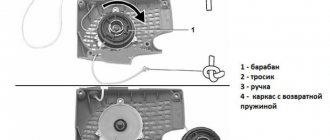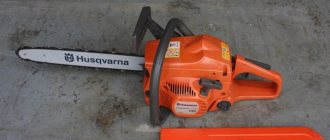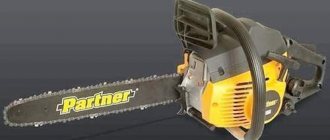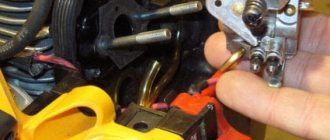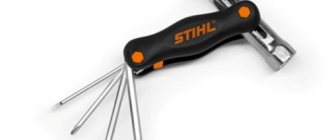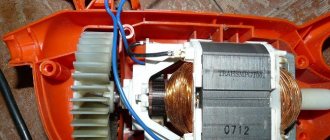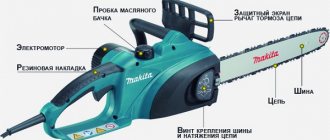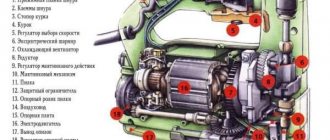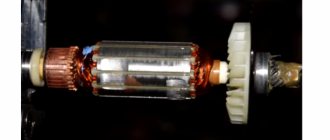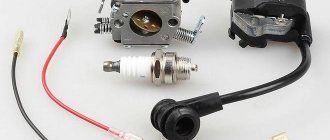No. 1. Chainsaw won't start
If you're having trouble starting your chainsaw, many people immediately turn to the carburetor. In fact, there are several options, and the cause of the problem could be any:
- Air and/or fuel filters are clogged. The problem can be solved by cleaning the filters.
- Lack of fuel in the tank. Yes, there is a reason. Some owners forget about such an insignificant detail as refueling a chainsaw, and think that a couple of liters of gasoline will last for six months. In addition, fuel should not be stored in the tank for more than 14 days, as gasoline evaporates and octane is lost.
- Check the line from the fuel tank to the carburetor. It may become clogged or broken to prevent gasoline from entering the tank.
- There is no spark at the spark plug. Why is there no spark? There can be many reasons: there is no contact, the spark plug needs to be changed, or it is flooded. Why pour a candle on a chainsaw is another question. But if this happens, it needs to be dried and reinstalled, and then checked for sparks. If the spark plug has severe carbon deposits, it is recommended to replace it.
- Check the muffler for carbon deposits. If there is soot, thoroughly clean the muffler, but it is still recommended to take the chainsaw to a service center so that they can check the cylinder and piston, since soot is a sure sign of a malfunction of the elements of the cylinder-piston group.
- The carburetor is clogged. How to properly adjust a chainsaw so that the carburetor works well is discussed in a separate article.
If none of the above methods help, the reason is more serious. Malfunction of one of the components of the connecting rod and piston group. In this case, it is recommended to take the chainsaw to a service center.
First warnings during repairs
A chainsaw consists of many parts. Let's highlight the main ones, such as:
- engine;
- fuel tank;
- ignition cable.
Since this is only a small part in a not very detailed description, it should be taken into account that chainsaws are almost identical in structure , which greatly simplifies their diagnosis and repair. Repairs can be greatly complicated if you do not contact a technician in time and continue to use the broken equipment. And it’s absolutely true that in order to repair a chainsaw, it is best to contact a specialist, because the future “life” of your “irreplaceable partner” at work depends on the repair.
So, when carrying out repairs, the master must check all the parts of the chainsaw , for which it is disassembled into parts. Most often, breakdowns occur from improper and careless operation of the device, which is why the fuel filter or breather often becomes clogged with sawdust. To diagnose a blockage, the technician disconnects the hose and checks how the fuel flows.
Fuel may also be supplied in insufficient quantities. This happens because the air filter becomes clogged, so it should be changed every three months.
One of the important elements of a chainsaw is the spark plug, which also needs to be checked. There are possible interesting reasons for the malfunction:
Recent Entries
Chainsaw or electric saw - what to choose for the garden? 4 mistakes when growing tomatoes in pots that almost all housewives make Secrets of growing seedlings from the Japanese, who are very sensitive to the soil
- dry candle;
- candle in oil;
- the candle may be shrouded in black soot.
If the spark plug is dry, it means no fuel is getting into the cylinder, and this, in turn, means that everything is fine with the ignition and the repairmen are looking for another problem. If the spark plug, on the contrary, is in oil, it means that there is excess fuel. In this case, you need to unscrew the spark plug and wipe it well , then put it back again.
Black soot on the spark plug means that while using it, the owner of the chainsaw mixed gasoline and oil in the wrong proportions. Be sure to check for a spark. As we can see, repairs are still not so simple and we still have a lot ahead of us. The process of restoring the functionality of a chainsaw also includes some processes for cleaning the elements of this device, such as the muffler. Let's analyze this operation step by step. To begin with, as in any repair, we need to find this part of our device, remove it and disassemble it. If there is a lot of carbon on it, then we need to clean it, and for this we will need:
- an ordinary rag;
- detergent;
- water.
These items can be found in any home. We clean our muffler completely of carbon deposits, after which it is important to dry it well so that the repair is not in vain and, of course, put it back in place.
Dry cleaning of the muffler is too dangerous for your health; carbon deposits contain a lot of carcinogens that can be accidentally inhaled!
No. 2. The engine stalls
The engine started, but only at idle or when loading stalls with a chainsaw. In this case, you should often follow the same steps as described above.
How to properly adjust a chainsaw depends on when the problems start:
Stalls immediately after starting:
- The fuel mixture is not prepared properly, there is too much oil in it, so the octane number of gasoline is less than it should be, so the chainsaw only works on suction or settles immediately.
- A blow to the spark plug or incorrect gap between the spark plug and wire.
READ At what degree to sharpen a chainsaw
It stalls and does not work at idle:
- The muffler is clogged. The deposit must be cleared.
- Carbon settings have been lost. The idle speed on the chainsaw needs to be adjusted. This is done using adjusting bolts marked L and H. For how to adjust idle speed, see the article on carburetor adjustment.
Stalls at maximum speed and only runs on choke
- The air or fuel filter is clogged. The seals need to be cleaned and checked.
- The fan is clogged, and because of this, fuel does not flow, and pumping gasoline to the chainsaw does not work. Take the needle and clean the breather thoroughly.
- Fuel pump malfunction. Remove the pump and check for gasoline leaks. If there is a leak, replace the gasket or the pump itself.
The chainsaw does not cut under load and stalls
- The air filter is clogged. You'll need to remove the filter, clean it, or even wash it, dry it, and reinstall it.
- Incorrect proportion of mixture of oil and gasoline. Drain the fuel and mix the oil and gasoline again in the correct proportions.
The chainsaw is heating up, what is the reason?
Check the fuel mixture. Firstly, it must be prepared according to the manufacturer’s recommendations and using high-quality ingredients. Secondly, exhaust the tank completely or drain the fuel mixture before long periods of inactivity or storage between seasons. Read more about fuel here: Gasoline for a chainsaw: which one to use? Gasoline for a chainsaw: which one to use?
Clean the air filter or change it.
Check the spark plug. There may also be several sub-items here. The first step is to unscrew the spark plug of the chainsaw and check whether it has flooded during startup attempts. This especially often occurs when the chainsaw is started by inexperienced users who do not follow the sequence of starting the saw when cold. In this case, you need to dry the spark plug or screw in a new one and try again according to the instructions. The spark plug tip may fail. You can check this by unscrewing the spark plug and inserting it into the tip, placing it on the block and pulling the starter cord a couple of times. If there is a spark, then the spark plug and other electrical components are in order. Another step in checking the spark plug is to check the spark plug gap and for carbon deposits. See the manufacturer's recommendations for clearance. As a rule, this is from 0.5 to 0.65 millimeters. Carbon deposits from the spark plug are cleaned with fine-grained sandpaper or a wire brush.
If the chainsaw stalls when you press the gas, it means that fuel is not supplied in the required volume. This is a reason to check the fuel filter.
Also in this case, the cause may be an incorrectly configured carburetor. Read about setting up the carburetor here: Setting up the carburetor
Another reason for unstable operation of a chainsaw may be a muffler clogged with carbon deposits. We remove the muffler and wash it using SMS, after it dries we install it back.
A chainsaw in a country house or in a private house is a common occurrence. It can be amateur, semi-professional and professional. The choice depends on the frequency and complexity of the activity. It greatly simplifies the work of collecting firewood and helps to quickly set up a log house. If it breaks down, in most cases it is possible to repair the chainsaw yourself. Equipment failure may be associated with idle speed problems, the mechanism does not start or malfunctions.
The repair principle for all chainsaws is approximately the same. Before work, be sure to read the instructions. With this type of equipment, the greatest difficulty is not the repair itself, but the search for the source of the breakdown.
No. 3. The engine "shoots"
If during operation there are extraneous sounds similar to gunshots, there is a problem with the muffler or carburetor. How to make a chainsaw work quietly? It depends on which node is faulty.
Shoots the carburetor:
- Ignition is too late. The fuel-air mixture does not have time to burn in the cylinder, so it makes a sound similar to a small explosion.
- Poor air-fuel mixture. Too little gas enters the mixture. To increase the fuel supply, you need to adjust the chainsaw, or rather the jets. Why does the chainsaw blow by itself? For the same reason.
Shoots at the silencer:
- Enriched air-fuel mixture. Why does a chainsaw “shoot”? The mixture contains too much gasoline and not enough air, so the mixture does not burn out completely in the chamber and partially burns out in the muffler. Exhaust soot. A clear sign of this. The air filter needs to be cleaned or the carburetor adjusted.
No. 6. The chainsaw cuts to the side
When cutting, you may notice that the cut is uneven. Why were you drinking crookedly with a chainsaw? There are several reasons:
- Incorrect chain sharpening. The teeth are sharpened at the wrong angle or in only one direction. Proper sharpening is not required.
- Incorrectly selected chain. At very high speeds you can see even a 0.2-0.3mm difference between the groove width or placement width, why chainsaw and side saws. You need to install the appropriate schema.
- Uneven tire wear. Over time, the tire wears on one side and then the chain moves to the side. Rotate the tire regularly so that it fits on both sides. If the wear is excessive, replace the tire.
READ How to Sharpen Pobedite Tipped Saws
No. 7. Chain lubrication problems
For proper operation, the chain must be constantly lubricated to reduce friction between the bar and the links, and also to prevent premature wear of the links.
- If the chain is not lubricated on your chainsaw, there is a problem with the oil pump. Oil is not supplied due to a clogged channel. Lack of oil causes the chain to stretch or break. Clean the channels, the smallest particles of wood chips get there and clog them. This can also break the oil hose. If you need to adjust the oil pump chainsaw or repair it, it is better to contact the service department.
- Oil splashes from the chain. Wrong oil selected. It's too thin, so don't lubricate the links as much as splatter on the wood. Replaces fat with thicker fat.
Problems with the STIHL MC 180 chainsaw
Question: During operation, the STIHL ms 180 c chainsaw stopped idling and stalled. I started it with difficulty, but stalled again at idle.
After this it does NOT want to start. The next day, after unsuccessful attempts to start it, I removed and washed the air filter. It didn’t help, I had to remove the candle. It turned out to be dry, although there were plenty of attempts to start it.
I cleaned the breather with a needle (it was not clogged). I changed the fuel filter (although the old one was NOT visually dirty). I cleaned the carburetor and installed a new spark plug just in case. Saw won't start! I unscrewed the spark plug again. dry. what to do?
Answer: Remove the muffler. Look at the piston, if there are longitudinal stripes on it, then it needs to be replaced.
Question: What is the difference between the drive and chain sprocket of the STIHL 180 chainsaw?
Answer: there is no difference between a “drive sprocket” and a “spin wheel”; these are different names for the same part.
Question: I bought a STIHL ms 180 chain saw, I really liked it, but I want to ask you if my saw can cut thick wood?
Answer: The standard length of the MS 180. 35 cm bar, it is possible to cut a log. 70 cm in diameter, if logs of this diameter predominate, then you need a chainsaw of greater power.
The MS 180 will, of course, cope with the task, slowly and surely sawing all large-diameter logs, but you need to remember that by giving heavy loads to the device, and not one created for this, you (at best) reduce the service life of the chainsaw, that is, it brings its lifespan closer repair.
Question: Please tell me, is it possible to use a 45 cm tire on the STIHL 180 chain duster?
Answer: MS 180 chain saws can be equipped with a bar of maximum length 40 cm.
Question: Where is the breather located in the STIHL MS 180 chainsaw?
Answer: The ventilation system valve (“breather”) is located “on top” of the gas tank and oil tank, it cannot be seen visually, because everything is covered by the starter housing.
Question: On the MS 180, the gas button gets stuck in a horizontal position. what to do?
Answer: Most likely, the lever-traction mechanism is faulty; when the unit is turned over, one of the levers or rods “falls”.
Question: Why does the cylinder heat up and when it heats up does the STIHL 180 chain saw stall?
Answer: The problem is in the ignition module, perhaps there is compression (necessary).
Question: We use a STIHL 180 chainsaw with a standard bar; we recently found out that people are installing a Carving bar on this model. According to the catalogue, it is possible to install a 30 cm tire of this type, but is it possible to install a 25 cm tire or is it not possible for this model?
READ Chainsaw Starts Up, Gains High Speed and Stalls
Answer: Carving has a very small nose radius. It is better to use a chain with a 1/4 pitch with this tire. And this is where the problems begin. Chains like this are very rarely available in retail, and plus the 180s you can also find 1/4 sprockets.
Maybe it makes sense to look for a 30 cm Rollomatic Mini tire on 3/8 1.1. Its article number is 3005 000 3905, if I’m not mistaken. She has a small nose with a 7-tooth star. Somewhat larger than carving, but not so picky about lubrication.
Question: Where should the arrow on the piston point to the muffler or vice versa on the STIHL 180 C chain saw?
Answer: The arrow should point towards the muffler (rule for all STIHL ).
Question: Tell me, what is the clutch thread (left or right) for MS 180 chain saws?
Answer: All STIHL have a left-hand thread on the clutch.
the STIHL chainsaw pulls out with a jerk, what is the reason?
Answer: There may be several reasons. from a faulty starter (starter spring, etc.), to a faulty cylinder-piston group.
Question: Why is there play in the chain sprocket on the STIHL 180 chainsaw?
Answer: The clutch cup needle bearing is worn out, but even on a new saw the chain sprocket has minimal play!
STIHL chain saw . Second fill of gasoline, full tank. Gasoline is seeping from below. Why?
Answer: The gas hose rubber could have popped out and could overflow through the gas tank breather. The first needs to be corrected, the second is acceptable!
STIHL chainsaws , the chain does NOT move during operation while the brake lever is in the middle position, and only begins to rotate when you pull it towards you. What can be wrong?
Answer: The chain brake in chainsaws has two positions: extreme, “pull away”. this is the brake in the “on” working position, the chain does NOT move; extreme “towards you”, move towards the clicks. This is the brake in the cocked position, the chain rotates.
You most likely have the brake on, you need to move the handle to the extreme “towards you” position, i.e. pull the handle until it clicks and if this does not help, then the brake is faulty and you need to contact a service center!
question: How to properly adjust the carburetor of a STIHL MC 180 chainsaw?
STIHL chain saw, only the idle speed is adjusted, since the carburetor is rolled and adjusted at the factory. The idle speed is adjusted so that the chain does not rotate at minimum speed, or according to the tachometer.
Question: Tell me what to do. The STIHL 180 chainsaw does not start . There is a spark, but the spark plug floods and it starts, but does not want to. Where to start repairing or disassembling?
Answer: All repairs must begin by removing the muffler and seeing what the piston looks like.
READ Oil Supply to Chainsaw Shtil 180
chainsaw does not stall when moving the lever up, I turn it off with the air damper, what should I do?
Answer: by moving the lever up, you interrupt the contact, in your case the contact is not interrupted, the contact spring has “moved away” (bent), the contact spring wire may be broken, the control shaft is worn out (the lever you are lifting up).
Question: Tell me how to replace the clutch springs STIHL
Answer: clutch springs can be replaced even without removing the clutch. All you need is a small but strong hook made of strong wire and a standard spark plug wrench. We remove the cup, put the key on the hexagon of the coupling and use the hook to unhook the stretched spring.
We immediately put a new one in its place. it's simple there. We hook one hook of the spring with our fingers, and use the hook to pull the second hook into the hole. It will catch, then we push it with a screwdriver so that it fits into the hole properly.
We turn the crankshaft 1/3 of a turn, put the key on the hexagon again, hold it from turning and also replace the spring with a new one. Further. third. We put the cup in place and work. You can also check the condition of the springs with your fingers.
The stretched spring allows the weights to move on the cross and is itself removed very easily. When we replace the springs with new ones, the clutch should become like a monolith and it is not possible to pull the weights off with your finger, only if you push against it with a screwdriver.
Question: Is it possible to install a STIHL MS 180 chainsaw instead of a standard 30 cm bar, 1.3 tires from 170 to 30 cm, but with a 1.1 groove? What is the threat of such a replacement?
Answer: In my opinion, only unnecessary consumption of chains. Still, 1.1 teeth are shorter (and on some models even much shorter), resulting in fewer sharpenings.
Gasoline is NOT supplied
To find the source of the breakdown and determine why the device does NOT pump gasoline, disconnect the gas lines from the carburetor. Try pumping fuel. If it feeds slowly, problems may include:
- in the fuel filter, it becomes clogged with debris;
- clogging of the gasoline supply channel.
Experts DO NOT fill the container with fuel to the brim. This may damage the device.
Smokes
If your equipment smokes or loses power, pay attention to the engine. Unstable starting and overheating may also indicate its breakdown.
there are sparks
Ignition problems are associated with a weak spark on the chainsaw or its absence. When checking the spark plug there may be a blue spark. This means that everything is fine. If there is no spark, check the high voltage cable. There may be a broken wire. Another option for why there is no spark is due to an incorrect gap between the ignition module and the flywheel magnetic circuit. The norm for this indicator is 0.2 mm.
No. 8. The chain falls off
Why does the chain fly off the tire? There may be several reasons, and they are all different:
- Worn drive or sprocket. As the sprocket wears, the grip on the chain decreases, causing the chain to fly out of the chainsaw. The sprocket needs to be replaced.
- The chain is tight. Why does a chainsaw chain stretch due to insufficient lubrication? The metal is heated and stretched, albeit by fractions of a millimeter, but given the number of links, even 3-4 mm is enough for the chain to fly off the tire. The scheme must be changed.
- The chain tensioner is loosened by adjusting its tension. How to adjust a chainsaw, or rather the chain tension? You need to adjust the tensioner. This can be done in just a few minutes.
No. 9. The chain does not rotate
Why doesn't my chainsaw chain rotate when the engine is running even at full speed?
- Leading star. Either it is stuck or the crown is so worn that it does not touch and the chain does not turn on the chainsaw. In any case, you need to disassemble the sprocket to find out the exact reason why the chain is not turning. If the crown is worn. It is necessary to replace the sprocket (or the crown itself, if the sprocket has a prefabricated structure).
- The brake chain is stuck. As a result, the sprocket is blocked by the brake mechanism when the engine is running. You need to turn off the engine and release the brakes. If this happens under load, the brake mechanism will have to be replaced like a sprocket, because due to the high temperature, many elements can melt and overheat.
Why does the chainsaw get hot?
Other renovations
Other damage may include a broken chain. If the reason is not a foreign object, the manufacturer may be using low quality metal. The chain may break as a result of overheating due to poor lubrication.
If the chain does NOT turn, but does not pull or jams, check whether you removed the brake after starting the engine. In some cases, it is necessary to replace the saw set after this.
Poor quality of the saw can cause the chain to quickly become dull. It is better to replace it with high-quality, branded components.
During operation, it happens that the chain does NOT stop. There may be 2 options here:
- Contaminated brake band. Dirt, dust, sawdust can get into the mechanism. This causes the brake mechanism to lock and the unit does NOT stop when the gas is released. Cleaning the unit will eliminate this problem.
- Brake band wear. Needs replacement.
If the drive sprocket wears out, the chain jams. This happens under load. Without it, the chain mechanism simply does not move.
Natural wear and tear of spare parts is not uncommon. This includes the drive sprocket, chain, tire, and components of the anti-vibration system. It is important to monitor and replace such elements in a timely manner; their failure can negatively affect the more expensive mechanisms of the device. Due to a worn drive sprocket and tire, increased vibration has a strong effect on the crankshaft bearings and leads to failure. Wear of 3-4 chains indicates that it is time to think about a new tire. It is subject to increased use from the bottom side.
Sources:
https://slavasozidatelyam.ru/strojka-i-remont/pochemu-greetsya-benzopila/
No. 10. Chain brake does not work
All chainsaws are equipped with a main and inertial (emergency) brake. The latter is activated only when hit on the back. The main brake is designed to stop the chain while the engine is running. Why is the chain on the chainsaw jammed and won't stop? There are two options:
- The brake lining is badly worn and does not provide sufficient braking effect. The brake belt needs to be replaced.
- The tape is dirty. During operation, the axillary space may become clogged with debris: shavings, sawdust, dirt, etc. Debris blocks the operation of the brake mechanism, so if the brake does not work, it is necessary to clean the brake mechanism.
Source
Many e-cigarette smokers face such a common problem as the device overheating during operation. An increase in temperature indicates a product malfunction that may lead to permanent failure. Therefore, it is necessary to consider why the lime heats up.
READ Starter Kickback When Starting Chainsaw
Chainsaw design and general classification of faults
The main condition for successful repair is correct diagnosis. Therefore, in order to determine why the chainsaw failed and, most importantly, how to make it work again, you first need to know the features of its design.
It should be noted that it is not particularly complex, as it includes:
- engine (two-stroke petrol);
- functional part (saw bar and chain);
- systems that ensure the joint operation of these two components (ignition, filtration, lubrication, etc.), that is, the tool as a whole.
In order to simplify the diagnosis of faults, they are usually distinguished into two main ones:
- engine malfunction;
- malfunctions of other chainsaw components.
Most often, failures occur in engine systems, however, other parts of the tool can fail at any time due to intensive use or improper care. How to determine exactly where the breakdown occurred? Simple logic will help us with this.
If the problem is in the engine, it will:
- won't start;
- stall;
- work unsteadily;
- overheat;
- smoke;
- develop insufficient power.
Why does an e-cigarette heat up?
Lime heats up for the following reasons:
- Wrong job. When the button responsible for the battery is held continuously for a long time, the coil overheats. The result is a “burnt” taste and smell, and the vape is very hot.
- Wrong pairs. Prolonged and deep puffing leads to strong heating of the electronic device.
- The wick is not wet enough.
- The appearance of soot on the spiral. Plaque is caused by prolonged or improper use.
- Lack of fluid. The e-cigarette becomes hot if there is not enough liquid in it. Thin fertilizer should be diluted with clean (preferably distilled) water.
- Incorrect connection between battery voltage and coil resistance. With high voltage and low resistance, the steam overheats.
- Faulty electronic cigarette. Battery problems, leaking wires, broken circuit board. All this leads to the device heating up quickly.
Basic chainsaw malfunctions: causes
Every year, manufacturers are developing equipment that is more complex and reliable in design, but simple to operate. Chainsaws are no exception. But no matter what modern features are included in the device, it is difficult to avoid chainsaw malfunction. Diagnosis of breakdowns can be carried out independently, using the operating instructions. Let's look at the main types of faults encountered.
Sags crookedly
Let's look at the reasons why a chainsaw cuts crookedly. This manifests itself during cutting under the load of the trunks, when the tire gradually moves to the side. This is especially noticeable when sawing a wide trunk using the double cut method, first from above, then from below. As a result, the output is an uneven sawn surface, which in some cases is unacceptable. An example is trimming bars.
- Uneven sharpening of saw teeth. This is the most common reason why the device cuts obliquely. The teeth should be ground to the same distance to avoid problems when sawing. The optimal solution is to purchase a sharpening machine that is adjusted to the most worn tooth of the saw mechanism. Or contact a workshop where such equipment is available. The result is that all teeth are the same size.
- The chain or bar used is not suitable. When purchasing these elements, you must consider the width of the groove. This is important not only for the correct operation of the equipment, but also for safety when cutting.
- The saw set of the device is very worn. If the device does not cut well, there may be increased wear on the headset. A visual inspection will indicate the problem. If the right or left side of the tire is more worn, it must be replaced with a new one. If there is increased wear, it makes sense to conduct a full diagnosis of the lubrication system. This often causes increased wear on one side of the chain.
In case of complex repairs, it is better to take the equipment to a specialized workshop.
It's getting warm
If a new chainsaw heats up, this is due to the fact that the elements of the piston group have not yet gotten used to it. In this case, it is necessary to run-in, avoiding overheating. If the problem is related to a device that is already in use, the cause may be late ignition. Sometimes the device overheats due to improper preparation of the combustible mixture.
Not gaining momentum
The problem appears on startup. The chainsaw does not develop speed, runs jerkily or idles, stalls, starts with a pusher, and kicks back when starting.
- If the device does not hold idle speed, the reasons may be a clogged filter, poor-quality fuel mixture, carburetor, ignition module, or deformation of the motor elements under load.
- If the saw does not develop traction at full power, pay attention to the carburetor. There is a possibility that the worker node settings are set incorrectly. Adjust the “H” jet, which is responsible for cutting under load. To do this, set the fuel supply at high rotation speed.
- Doesn't slow down. The problem is that the device can quickly develop speed at high speeds and not drop it. It is necessary to check the functioning of the throttle valve, switching the toggle switch, and the presence of a corkscrew on the throttle shaft.
- Uncontrollably picks up rotation speed. The reasons may be in the carburetor, fuel supply system, connecting elements leading to the carburetor.
- The technique only works on suction. The reason is improper preparation of the fuel mixture, a large amount of oil.
The correct way is burning
Burns. A complex and delicate procedure. The slightest deviation in the process results in damage that cannot be repaired. The purpose of combustion is to clean the spray when other methods fail.
The procedure is performed in the following sequence:
- The atomizer is unscrewed from the main part of the electronic cigarette, blown out and washed with clean water;
- The battery is connected to the injector, the power button is pressed several times (7-10 times), holding for 4-5 seconds;
- After cooling, the purging element is repeated;
- 3-4 drops of lime liquid are applied to the bridge of the sprayer;
- The device is coming.
After these manipulations, the electronic cigarette can be used in the future.
Correct selection of the spiral
Overheating of the lime can lead to burnout of the coil, as a result of which it must be replaced. Battery voltage is taken into account when choosing. If the coils are not selected correctly, the part will burn out when the battery voltage is high and the resistance is low.
The spiral resistance value is classified as follows:
- High resistance (resistance more than 2.6 ohms);
- In average resistance (resistance 1.9-2.6 ohms);
- Low resistance (resistance 1.4-1.8 ohms).
The most popular are vapes with a resistance of 1.8 Ohm and a voltage of 3.7 V.
Source
